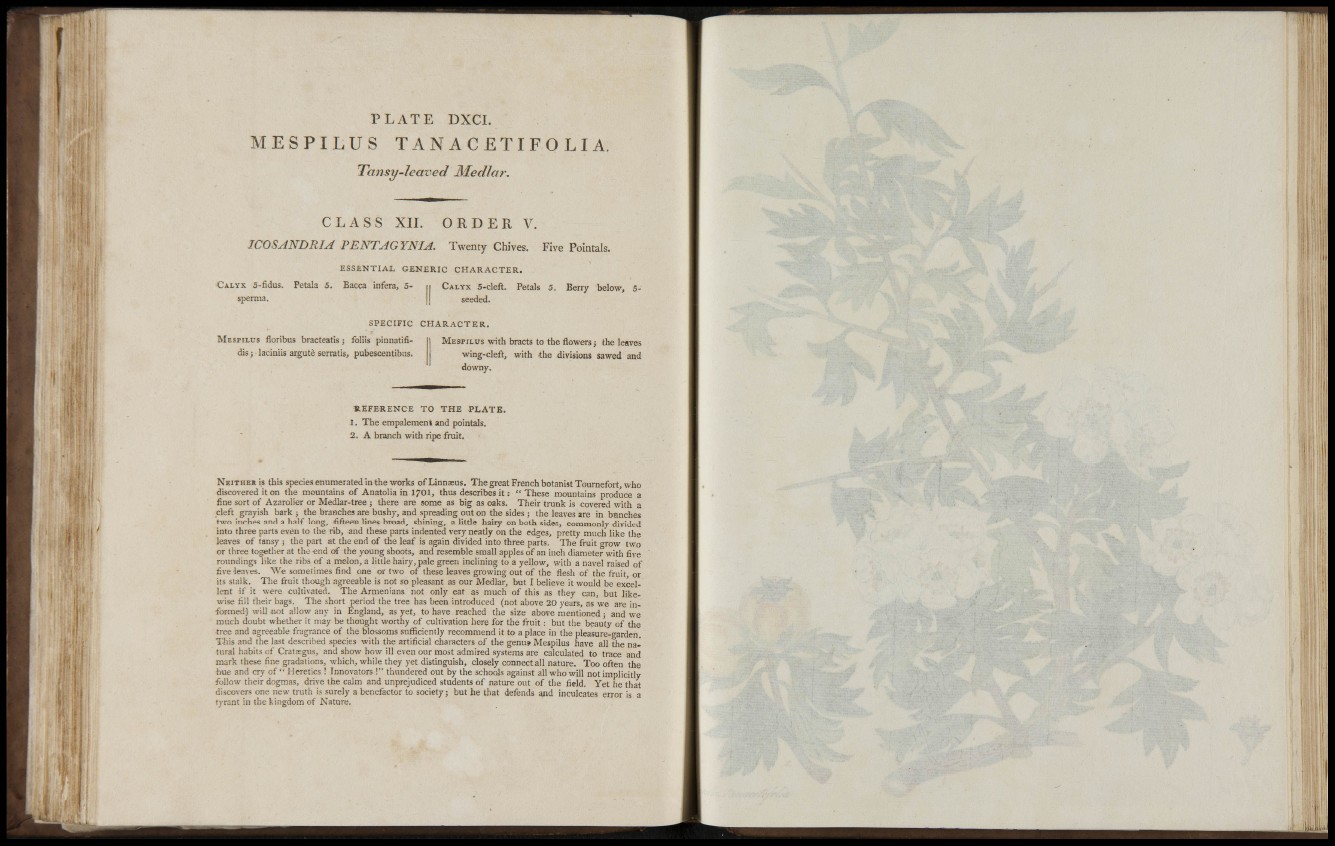
f
u
' h
!
i ;
P L A T E DXCL
M E S P I L U S TANACETIFO LIA.
Tansy-leaved Medlar.
C L A S S XII. ORDER V.
ICOSANDRIA PENTAGYNIA. Twenty Chives. Five Pointais.
E S S E N T I A L GENERIC CHARACTER.
CALYX 5-fidus. Pétala 5. Bacca infera, 5-
sperma.
CALYX 5-cleft. Petals 5. Berry below, 5-
seeded.
S P E C I F I C CHARACTER.
MESPILUS floribus bracteatis J folils pinnatifidis
-, laciniis argutè serratis, pubescentibus.
MESPILUS with bracts to the flowers; the leaves
wing-cleft, with the divisions sawed and
downy.
R E F E R E N C E TO THE PLATE,
1. The empalement and pointais.
2 . A branch with ripe fruit.
NEITHER is this species enumerated in the works ofLinnaeus. The great French botanist Tournefort who
discovered it on the mountains of Anatolia in 1/01, thus describes it : " These mountains produce a
fine sort of Azarolier or Medlar-tree ; there are some as big as oaks. Their trunk is covered with a
cleft grayish bark ; the branches are bushy, and spreading out on the sides ; the leaves are in bunches
two inches and a half long, fifteen lines broad, shining, a little hairy on both sides, commonly divided
into three parts even to the rib, and these parts indented very neatly on the edges, pretty mucli like the
leaves of tansy ; the part at the end of the leaf is again divided into three parts. The fruit grow two
or three together at the end of the young shoots, and resemble small apples of an inch diameter with five
roundings like the ribs of a melon, a little hairy, pale green inclining to a yellow, with a navel raised of
five leaves. We sometimes find one or two of these leaves growing out of the flesh of the fruit, or
its stalk. The fruit though agreeable is not so pleasant as our Medlar, but I believe it would be excellent
if it were cultivated. The Armenians not only eat as much of this as they can, but likewise
fill tTieir bags. The short period the tree has been introduced (not above 20 years, as we are itifor.
med) will not allow any in England, as yet, to have reached the size above mentioned ; and we
much doubt whether it may be thought worthy of cultivation here for the fruit : but the beauty of the
tree and agreeable fragrance of the blossoms sufficiently recommend it to a place in the pleasure-garden
This and the last described species with the artificial characters of the genu.» Mespilus have all the natural
habits of Crataegus, and show how ill even our most admired .systems are calculated to trace and
mark these fine gradations, which, while they yet distinguish, closely connect all nature. Too often the
hue and cry of " Heretics ! Innovators !" thundered out by the schools against all who will not implicitly
follow their dogmas, drive the calm and unprejudiced students of nature out of the field. Yet he that
discovers one new truth is surely a benefactor to society ; but he that defends and inculcates error is a
tyrant in the kingdom of Nature.
!! 'i.'fl
i i:'
E'f t
3 ruv-
«II
I,
• 11
:
rl!
f .1